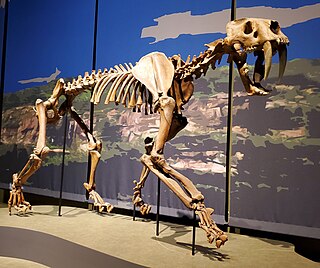
Smilodon is a genus of felids belonging to the extinct subfamily Machairodontinae. It is one of the best known saber-toothed predators and prehistoric mammals. Although commonly known as the saber-toothed tiger, it was not closely related to the tiger or other modern cats. Smilodon lived in the Americas during the Pleistocene epoch. The genus was named in 1842 based on fossils from Brazil; the generic name means "scalpel" or "two-edged knife" combined with "tooth". Three species are recognized today: S. gracilis, S. fatalis, and S. populator. The two latter species were probably descended from S. gracilis, which itself probably evolved from Megantereon. The hundreds of specimens obtained from the La Brea Tar Pits in Los Angeles constitute the largest collection of Smilodon fossils.

The cave bear is a prehistoric species of bear that lived in Europe and Asia during the Pleistocene and became extinct about 24,000 years ago during the Last Glacial Maximum.

The woolly rhinoceros, simply known as woolly rhino, is an extinct species of rhinoceros that inhabited northern Eurasia during the Pleistocene epoch. The woolly rhinoceros was a member of the Pleistocene megafauna. The woolly rhinoceros was covered with long, thick hair that allowed it to survive in the extremely cold, harsh mammoth steppe. It had a massive hump reaching from its shoulder and fed mainly on herbaceous plants that grew in the steppe. Mummified carcasses preserved in permafrost and many bone remains of woolly rhinoceroses have been found. Images of woolly rhinoceroses are found among cave paintings in Europe and Asia. The species range contracted towards Siberia beginning around 17,000 years ago, with the youngest known records being around 14,000 years old in northeast Siberia, coinciding with the Bølling–Allerød warming, which likely disrupted its habitat.
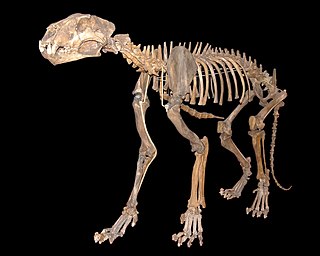
Panthera spelaea, also known as the cave lion or steppe lion, is an extinct Panthera species that most likely evolved in Europe after the third Cromerian interglacial stage, less than 600,000 years ago. Genetic analysis of ancient DNA has revealed that while closely related, it was a distinct species genetically isolated from the modern lion occurring in Africa and Asia, with the genetic divergence between the two species variously estimated between 1.9 million and 600,000 years ago. It is closely related and probably ancestral to the American lion. The species ranged from Western Europe to eastern Beringia in North America, and was a prominent member of the mammoth steppe fauna. It became extinct about 13,000 years ago.

Panthera atrox, better known as the American lion, also called the North American lion, or American cave lion, is an extinct pantherine cat. Panthera atrox lived in North America during the Pleistocene epoch, from around 340,000 to 12,800 years ago. The species was initially described by American paleontologist Joseph Leidy in 1853 based on a fragmentary mandible (jawbone) from Mississippi; the species name ('atrox') means "savage" or "cruel". The status of the species is debated, with some mammalogists and paleontologists considering it a distinct species or a subspecies of Panthera leo, which contains living lions. However, novel genetic evidence has shown that it is instead a distinct species derived from the Eurasian cave or steppe lion, evolving after its geographic isolation in North America. Its fossils have been excavated from Alaska to Mexico. It was about 25% larger than the modern lion, making it one of the largest known felids.

Gigantopithecus is an extinct genus of ape that lived in southern China from 2 million to approximately 300-200,000 years ago during the Early to Middle Pleistocene, represented by one species, Gigantopithecus blacki. Potential identifications have also been made in Thailand, Vietnam, and Indonesia. The first remains of Gigantopithecus, two third molar teeth, were identified in a drugstore by anthropologist Ralph von Koenigswald in 1935, who subsequently described the ape. In 1956, the first mandible and more than 1,000 teeth were found in Liucheng, and numerous more remains have since been found in at least 16 sites. Only teeth and four mandibles are known currently, and other skeletal elements were likely consumed by porcupines before they could fossilise. Gigantopithecus was once argued to be a hominin, a member of the human line, but it is now thought to be closely allied with orangutans, classified in the subfamily Ponginae.

Carnassials are paired upper and lower teeth modified in such a way as to allow enlarged and often self-sharpening edges to pass by each other in a shearing manner. This adaptation is found in carnivorans, where the carnassials are the modified fourth upper premolar and the first lower molar. These teeth are also referred to as sectorial teeth.
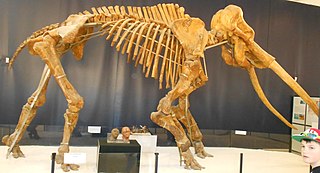
The straight-tusked elephant is an extinct species of elephant that inhabited Europe and Western Asia during the Middle and Late Pleistocene. It was larger than any living elephant, with adult males suggested to reach 3.81–4.2 metres (12.5–13.8 ft) in shoulder height, and 11.3–15 tonnes in weight. Like modern elephants, the straight-tusked elephant lived in herds, flourishing during interglacial periods, when its range would extend as far north as Great Britain. Skeletons found in association with stone tools and wooden spears suggest they were scavenged and hunted by early humans, including Neanderthals. It is the ancestral species of most dwarf elephants that inhabited islands in the Mediterranean.

Anancus is an extinct genus of "tetralophodont gomphothere" native to Afro-Eurasia, that lived from the Tortonian stage of the late Miocene until its extinction during the Early Pleistocene, roughly from 8.5–2 million years ago.

Sinomastodon is an extinct gomphothere genus known from the Late Miocene to Early Pleistocene of Asia, including China, Japan, Thailand, Myanmar, Indonesia and probably Kashmir.

The cave hyena, also known as the Ice Age spotted hyena, is a paleosubspecies of spotted hyena in Eurasia, which ranged from the Iberian Peninsula to eastern Siberia. It is one of the best known mammals of the Ice Age and is well represented in many European bone caves. It preyed on large mammals, and was responsible for the accumulation of hundreds of large Pleistocene mammal bones in areas including horizontal caves, sinkholes, mud pits, and muddy areas along rivers.

Post-canine megadontia is a relative enlargement of the molars and premolars compared to the size of the incisors and canines. This phenomenon is seen in some early hominid ancestors such as Paranthropus aethiopicus.
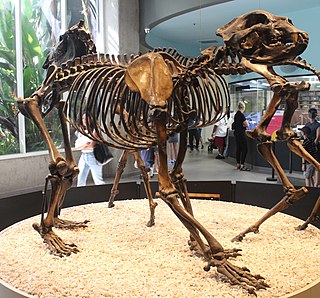
Arctodus is an extinct genus of short-faced bear that inhabited North America during the Pleistocene. There are two recognized species: the lesser short-faced bear and the giant short-faced bear. Of these species, A. simus was larger, is known from more complete remains, and is considered one of the most charismatic of North America's megafauna. A. pristinus was largely restricted to the Early Pleistocene of the Eastern United States, whereas A. simus had a broader range, with most finds being from the Late Pleistocene of the United States, Mexico and Canada. A. simus evolved from A. pristinus, but both species likely overlapped in the Middle Pleistocene. Both species are relatively rare in the fossil record.
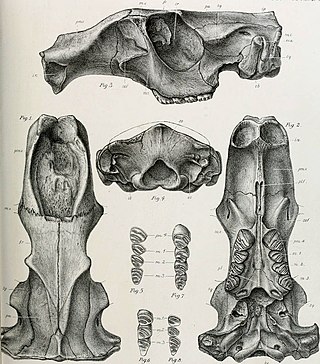
Trogontherium is an extinct genus of Eurasian giant beavers that lived from the Late Pliocene to the Late Pleistocene. Fossils of Trogontherium have been found across northern Eurasia, from Western Europe to China and Siberia.

Stephanorhinus kirchbergensis, also known as Merck's rhinoceros or the forest rhinoceros, is an extinct species of rhinoceros belonging to the genus Stephanorhinus from the Middle to Late Pleistocene of Eurasia. Its range spanned from western Europe to eastern Asia. Among the last members of the genus, it co-existed alongside Stephanorhinus hemitoechus in the western part of its range.
Ursus dolinensis is an extinct mammalian carnivore species of the Ursidae family. Its fossilized remains were unearthed from the lowest layers of the stratigraphic sequence at the archaeological and paleontological site of Gran Dolina, that is a part of the Atapuerca Mountains complex in the Burgos province, northern Spain. The species was described by Nuria Garcia and Juan Luis Arsuaga in a 2001 publication. Skeletal fossils, mainly cranial fragments were recovered from the sediment units TD 3 and in particular TD 4. Presence in these layers suggests a chronology in between 900,000 and 780,000 years ago, which falls into the Calabrian stage of the early Pleistocene.
Ursus ingressus is an extinct species of the family Ursidae that lived in Central Europe during the Late Pleistocene. It is named after the Gamssulzen Cave in Austria, where the holotype of this species was found.
This paleomammalogy list records new fossil mammal taxa that were described during the year 2019, as well as notes other significant paleomammalogy discoveries and events which occurred during that year.
Dental microwear analysis is a method to infer diet and behavior in extinct animals, especially in fossil specimens. Typically, the patterns of pits and scratches on the occlusal or buccal surface of the enamel are compared with patterns observed in extant species to infer ecological information. Hard foods in particular can lead to distinctive patterns. Microwear can also be used for inferring behavior, especially those related to the non-masticatory use of teeth as 'tools'. Other uses include investigating weaning in past populations. Methods used to collect data initially involved a microscope and manually collecting information on individual microwear features, but software to automatically collect data have improved markedly in recent years.
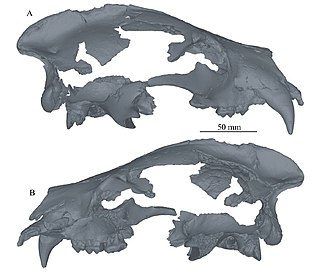
Protarctos is an extinct genus of basal ursine bear that lived in North America and Eurasia during the Pliocene and into Early Pleistocene.
















